Brazilian Diamonds: A Historical and Recent Perspective
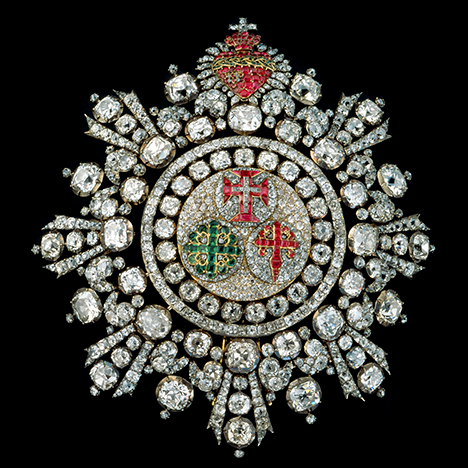
ABSTRACT
Brazil, which commanded global production in the 1700s and early 1800s, has remained a continuous source of diamonds for three centuries. Even though the country represented less than 1% of world production in 2015, a number of large famous diamonds, as well as fancy-color diamonds, have originated there. The sources are primarily alluvial, with diamonds transported by and deposited along a multitude of rivers. The diamonds are found mainly by independent miners (garimpeiros) in riverbeds, in unconsolidated sediments, and in compacted sedimentary conglomerates. After a century of exploration for the primary sources, some economically viable kimberlite pipes have been discovered in recent years, with one occurrence now being developed for mining. This article traces the country’s fascinating diamond history before focusing on the geologic setting of the diamond occurrences, as well as the challenges and future outlook for production. The locations of the secondary deposits, principally in the states of Minas Gerais and Mato Grosso, are presented.
INTRODUCTION
While Brazil is widely known for the production of colored gemstones, it is often not recognized as a source of gem diamonds (figure 1). Yet diamonds were discovered in the early 1700s by artisanal miners looking for gold along the banks of the Jequitinhonha River near the village of Arraial do Tijuco (later named Diamantina) in the state of Minas Gerais (Calógeras, 1904; Leonardos, 1959; Barbosa, 1991; Cornejo and Bartorelli, 2010). For the next 150 years, Minas Gerais was the world’s major supplier of gem diamonds. Beginning in the early 1840s, unusual polycrystalline black diamonds (or carbonados) were also recovered, mainly from the state of Bahia (Karfunkel et al., 1994).
As Africa emerged as the major diamond source in the 1870s, Brazilian mining decreased dramatically within a decade, principally because of the low grade of the alluvial deposits. According to Kimberley Process statistics, Brazil produced 31,825 carats in 2015, although this figure is likely a low estimate considering the lack of accurate reporting there. Despite its low output relative to other sources, Brazil has produced a significant number of large rough diamonds (Svisero, 1995; Hoover and Karfunkel, 2009; also see table 1). The geologic explanation for this abundance of large crystals is not yet clear. Highly valued colored diamonds are also found, including yellows and occasionally greens, pinks, and reds.
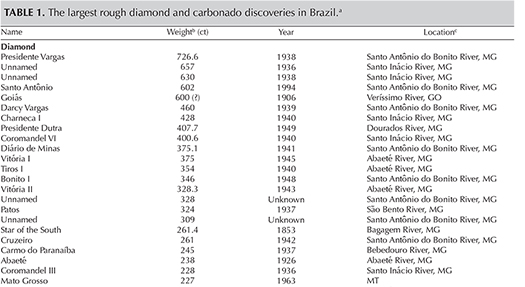
In most countries, diamonds are usually recovered from primary kimberlite pipes of volcanic origin. Brazilian diamonds, however, occur in secondary deposits over large watersheds or sedimentary rock formations. The diamonds are recovered by artisanal miners called garimpeiros, using simple tools and operating individually or in small groups. The diamonds are found as loose crystals obtained either by panning or dredging in the rivers, or by washing and/or breaking down the sediments that contain them (figure 2). Kimberlite bodies have been found in Brazil, but only one in Bahia is now being mined. Despite extensive exploration, none of the known kimberlites seems to account for Brazil’s abundance of alluvial diamonds. The long history of diamond production in the country, combined with the absence of obvious primary sources, has led to various theories on the geologic origin of these diamonds (see Chaves et al., 2001). This article will review the history of diamonds in Brazil, the locations and geologic settings of the principal diamond deposits, and the mining methods used to recover them.
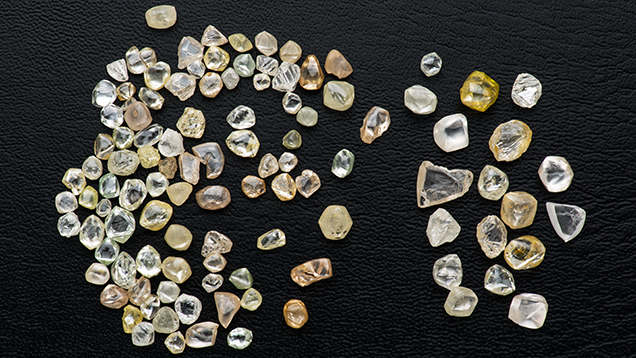
BACKGROUND
The first European explorers to reach the New World in the late 1400s were focused on finding spices and gold rather than diamonds. The Italian explorer and navigator Christopher Columbus set sail under the Spanish flag in 1492 in search of a more direct route to the “Indies,” the region of the Indian subcontinent and eastern Africa that was rich in spices, gemstones, pearls, and gold (Fernandez-Armesto, 2009). After a five-week westward voyage, Columbus discovered an island in the Caribbean and called it San Salvador. Portugal and Spain, the global powers of the day, understood that to avoid future confrontation, they had to subdivide the recently discovered lands in the New World. The Treaty of Tordesilhas, drawn up by Pope Alexander VI and signed by the two empires in 1494, drew a meridian that would effectively divide South America (which had yet to be discovered by Europeans) from north to south (figure 3). Spain would receive the lands west of the meridian, including modern-day Venezuela, Colombia, Ecuador, and Peru, while Portugal gained the eastern side. On his third trip to the New World in 1498, Columbus discovered the mouth of the Orinoco River in what is today Venezuela. Here was the key to reaching a vast continental interior concealed in the jungles behind the Atlantic coastline.
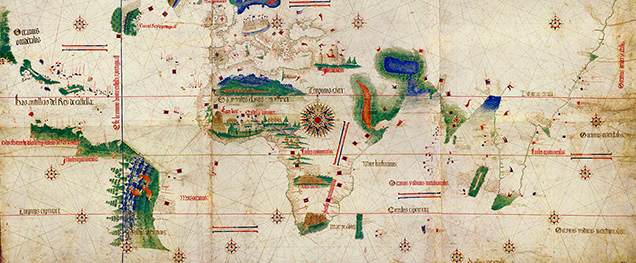
To open a new trade route to India that did not require passing through the Mediterranean, Portuguese nobleman Pedro Álvares Cabral was dispatched in early 1500 with a fleet of ships. His mission was to reach India by traveling south around the tip of Africa. His fleet landed instead on the coast of Brazil, which he claimed for Portugal on April 22 of that year. The voyages of Amerigo Vespucci, the Florentine navigator after whom the continent is named, took place around the same time. As he sailed south along the Brazilian coast, Vespucci realized that the continent was much larger than previously recognized. These expeditions were the first to bring back shipments to Portugal of pau brasil (Brazilwood), a tree sought after not only for timber but for a desirable red dye (Reid, 2014). Over the next two centuries, more European adventurers came to South America, most of them seeking riches in the form of gold, silver, and emeralds.
Between 1534 and 1536, King John III of Portugal divided the coastal regions of Brazil into 15 captaincy colonies to encourage development; these areas were given to Portuguese noblemen to administer and explore. Within a few years, most of these captaincies failed for a number of reasons. With this setback as well as the presence of French ships along the coast, the Portuguese crown decided to turn Brazil into a royal enterprise in 1549. Several successive governors-general were appointed to administer the colony, which was divided in 1621 into the states of Maranhão (in the north) and Brazil (in the south).
The exploration of Brazil’s vast interior was left to Portuguese adventurers, known as bandeirantes (flag bearers), who claimed territories for Portugal and the Catholic Church. While Spanish conquests in the New World met resistance from powerful empires—the Aztecs in Mexico and the Incas in Peru—the Portuguese were confronted with numerous small native tribes and a forbidding interior.
Exploration and conquest on both sides of the Tordesilhas meridian would soon rewrite the gemological texts of the time. For example, Spanish exploitation of emeralds in the territory of New Granada (modern-day Colombia) would vastly change the world’s understanding and appreciation for the gem, particularly in Europe (Weldon and Jonathan, 2013). Brazil would emerge as a major source for dozens of colorful gem species. It would also become, for a period, the world’s most prolific source of diamonds (Cornejo and Bartorelli, 2010).
PORTUGUESE EXPLORERS
Much of the early exploration and colonization of Brazil was undertaken by the bandeirantes. The bandeiras, funded by the crown and the Catholic Church, were large quasi-military expeditions comprised of hundreds of free men and slaves who ventured into the interior, capturing and enslaving indigenous groups they encountered (de Galvão Bueno, 1922). Along with a Jesuit priest, explorer Francisco Bruzo Espinoza mounted the first bandeira in 1554, in search of emerald. It was a short-lived and fruitless expedition. Successive expeditions also failed, though in 1572 Sebastião Fernandes Tourinho found green and blue gems (likely tourmaline) along the tributaries of the Jequitinhonha and Doce Rivers in what is now Minas Gerais. The success of Tourinho’s discoveries attracted more adventurers (Draper, 1950a).
In 1695, at Rio das Velhas, Manuel Borba Gato finally discovered gold, triggering a rush that would lead to the settlement of Vila Rica (later Ouro Preto) in 1698 (figure 4). The town played a leading role in Brazilian history for the next two centuries as the capital of Minas Gerais from 1720 to 1897 (Dodge, 1922). Settlements at Mariana, São Bento, Serro Frio, and Arraial do Tijuco soon followed the gold discoveries in those areas of Minas Gerais, and dozens more sprang up in Brazil’s interior. The north-south road system in Minas Gerais, known as the Estrada Real or “royal highway,” begun in 1697, was built to promote trade, economic development, and communication. Minerals, wood, and other natural resources were transported along the road from the interior to the coast for shipment to Lisbon (figure 5). Manufactured goods from Portugal were also carried inland. The road was strictly regulated by the crown to prevent smuggling and unauthorized movement of goods. It was also the only official route for traveling inland (Cheney, 2005).
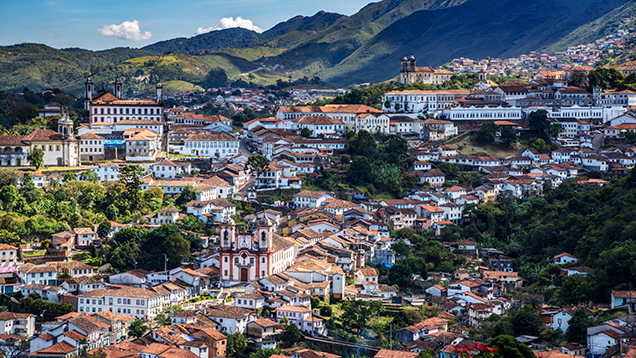
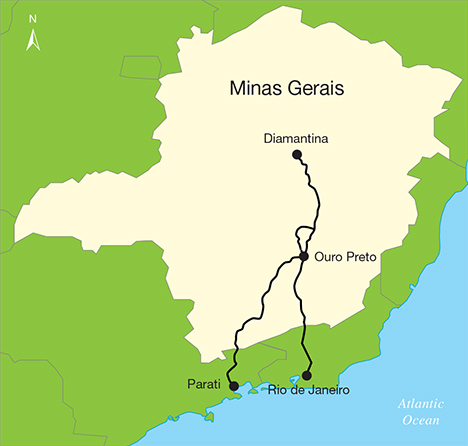
As Brazil’s population grew from European settlement, larger farms were required to grow crops, and indigenous tribes were used as a source of slave labor. Slaves were also imported from Portugal’s African colonies to work the farms. The combination of slave labor and the colony’s immense wealth of minerals and wood provided Portugal with unique imports for the European market (Reid, 2014).
EARLY REPORTS ON BRAZILIAN DIAMONDS
Early indications of Brazil’s diamond potential were sporadic, but there is evidence that crystals were found in Bahia within a century of Columbus’s discovery of the New World. In one of the earliest descriptions, historian Pero de Magalhães Gândavo (1576) mentioned the existence of “certain mines of white stones such as diamonds.” In another account, Gabriel Soares de Sousa (1587) noted that fine, eight-sided crystals—possibly diamond—had been found during the dry winter months along certain rivers.
English adventurer Anthony Knivet, who was captured and later escaped during a raid of Portuguese settlements in southern Brazil led by the English privateer Thomas Cavendish, described seeing what he believed to be diamond crystals while living among the natives in the late 1590s (Lessa de Sá, 2015). This would have been another of the earliest accounts of Brazilian diamonds, though no details were provided and the crystals could have been other gems such as quartz.
In 1695, gold was discovered in the mountainous region near Ouro Preto (Southey, 1819), and over the following decade thousands of miners flocked from the coast to the interior in search of the precious metal (Machado and Figueirôa, 2001). Near the village of Arraial do Tijuco in the northern part of Minas Gerais, unusually bright transparent crystals kept showing up in the panned river gravels in the early 1700s. In some cases, the miners disregarded them. Dos Santos (1868) recalled that men sometimes used these crystals as small markers in card games. A similar account says that in 1721 a gold miner secured several of these markers, which were later recognized as diamonds by someone who had traveled in the Golconda region of India (Oakenfull, 1919; see also Cornejo and Bartorelli, 2010).
The discovery of Brazilian diamonds is supported by the account of the Dutch explorer Jacob Roggeven (or Roggewein). As reported in Kerr (1824), Roggeven’s three ships anchored off the coast near São Paulo for a short time in November 1721 before resuming their voyage to the Pacific Ocean. Several crewmembers deserted to go to the diamond mining area:
A little time before the arrival of Roggewein, the Portuguese had discovered a diamond mine not far from St Sebastian [a coastal village near São Paulo], of which at that time they were not in full possession, but were meditating an expedition against the Indians, in order to become sole masters of so valuable a prize; and with this view they invited the Dutch to join them, promising them a share in the riches in the event of success. By these means, nine of our soldiers were tempted to desert. I know not the success of this expedition; but it is probable that it succeeded, as great quantities of diamonds have since been imported from Brazil into Europe. They are said to be found on the tops of mountains among a peculiar red earth containing a great deal of gold; and, being washed down by the great rains and torrents into the vallies, are there gathered.
Eventually, reports of diamonds in Minas Gerais began to reach Europe. Accounts from the colonial governor came to the attention of both King John V and the Catholic Church in Portugal, and the discovery was officially announced in 1729 (Ball, 1929). As Lisbon’s economic clout in Europe had waned somewhat, this was welcome news. In Minas Gerais, there was a diamond rush in the many rivers and streams around Arraial do Tijuco. Portugal moved aggressively to control the area, restricting gold and diamond mining and imposing high taxes. Despite efforts by the crown, clandestine mining and diamond smuggling increased. Draper (1950b) noted:
The diamonds played a prominent part in shaping the destiny of Portugal. Wealth derived from its diamonds not only helped place that country at the zenith of its glory but also contributed, at a later stage, to its release from the French occupation by paying part of the indemnity exacted by France during the Napoleonic wars (1807-1814).
The occurrence of alluvial diamonds around Arraial do Tijuco was reported in the scientific literature by de Castro Sarmento (1731). Over time, Arraial do Tijuco became the town of Diamantina (figure 6), the diamond trading center during Brazil’s tenure as the world’s leading exporter. To properly dredge, reroute, and mine the rivers around Diamantina required hard manual labor. This need coincided with the growth of the sugarcane business in Brazil’s northeast, and slaves were imported from modern-day Angola, Congo, and Mozambique to fill the needs of both industries. Much like Ouro Preto, Diamantina grew into a rich and picturesque city in the 18th and 19th centuries.
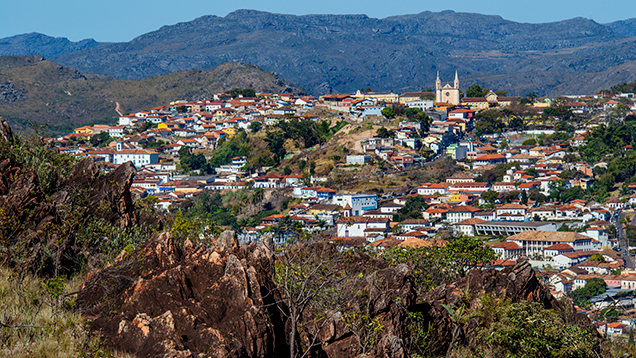
Oakenfull (1919) reported that between 1732 and 1771, “at least 1,666,500 carats of diamonds were exported to Europe.” That figure represents an average of about 42,000 carats per year. While miniscule by today’s standards, it placed Brazil squarely as the world’s top diamond producer at the time, eclipsing India’s Golconda region. The glut of Brazilian diamonds pouring into Europe caused for a time a steep decline in prices. Consequently, there were efforts to protect the value of the Indian diamonds on the market by disparaging the quality of Brazilian diamonds (Cassedanne, 1989). Oversupply was put to an end in 1739 when Portugal stepped in to monopolize the Brazilian mines, but by then the Golconda mines had stopped producing. An arrangement with financiers in Amsterdam ensured a steady supply of Brazilian rough for the city’s diamond cutters. And despite Portuguese oversight, smuggled Brazilian diamonds also found their way to London, another major center for rough diamonds and jewelry production (Hofmeester, 2013a). For more on the early cutting styles for Brazilian diamonds, see figure 7 and box A.
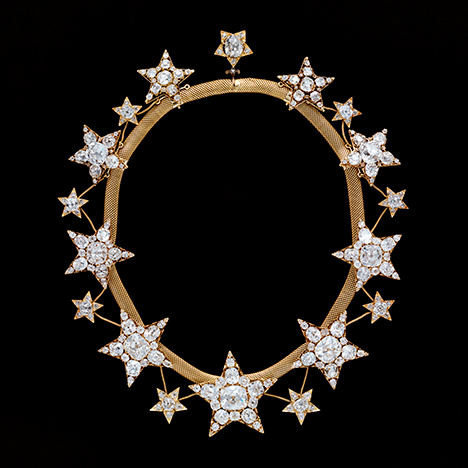
During this period, additional alluvial sources were discovered. Diamonds were found in the Mato Grosso region in 1746, and subsequently in other rivers in Minas Gerais. The Jequitinhonha River near Diamantina and the surrounding area yielded impressive quantities of alluvial diamonds as well (figure 8), including treasure troves in “potholes” or traps in the river bedrock. But the primary source of diamonds in Minas Gerais—actual diamondiferous kimberlites—remains elusive. As Sinkankas (1977) noted:
The original host rocks of the diamond crystals remain unknown despite much past speculation, “proof” of host rock sources by some authorities, and modern intensive geologic exploration of the regions presently yielding diamonds. Brazilian diamonds are found in a sort of matrix to be sure, this being a conglomerate of well-rounded pebbles cemented together with sand and iron oxides.
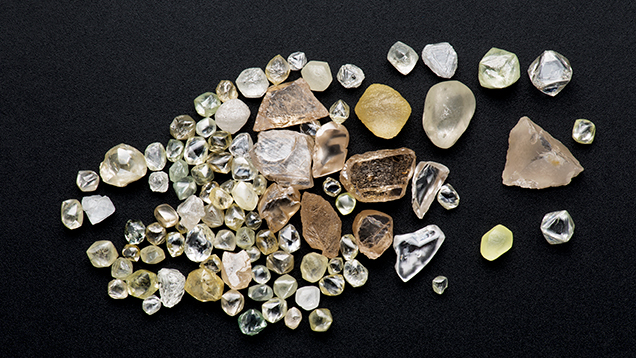
In 1733, Portuguese authorities began granting royal licenses to individuals to work portions of the diamond deposits. Guarded mule trains transported the diamonds along the Estrada Real to Parati and Rio de Janeiro (“Diamond carriers,” 1842). This licensing system eventually broke down, as bands of runaway slaves and garimpeiros clandestinely worked the areas or stole the recovered diamonds. In 1772, the government abandoned this system and took full control of the workings around Diamantina (von Spix and von Martius, 1824).
The English mineralogist John Mawe is probably the most celebrated European traveler to Brazil’s interior, having been the first foreigner to reach the diamond mines. In 1809 he received approval and funding from the Portuguese crown for his visit. His descriptions of the diamond region are still some of the most detailed. A vivid portrayal of the washing plants and the diamond discovery methods emerges in his 1812 account, Travels in the Interior of Brazil:
A shed is erected in the form of a parallelogram…consisting of upright posts which support a roof thatched with long grass. Down the middle of the area of this shed a current of water is conveyed through a canal covered with strong planks, on which the cascalhão [a Portuguese term for gravel] is laid two or three feet thick. On the other side of the area is a flooring of [sloped] planks… The flooring is divided into about twenty compartments or troughs…by means of planks placed on their edge. The upper ends of these troughs communicate with the channel, and are so formed that water is admitted into them…The negroes enter the troughs, each provided with a rake…with which he rakes into the trough…[the] cascalhão. The water being let in upon it, the cascalhão is spread abroad and continually raked up to the head of the trough, so as to be kept in constant motion. [After the finer sediment is removed], the gravel-like matter is raked up to the end of the trough, and…then the whole is examined with great care for diamonds. When a negro finds one, he immediately stands upright and claps his hands, then extends them, holding the gem between his fore-finger and thumb; an overseer receives it from him, and deposits it in a gamella or bowl…In this vessel all the diamonds found in the course of the day are placed, and at the close of work are taken out and delivered to the principal officer, who, after they have been weighed, registers the particulars in a book kept for that purpose.
Mawe’s successful journey prompted other European explorers to follow in his footsteps. His account, and the illustrations in his book by noted mineralogist James Sowerby, inspired many European scientists from a variety of disciplines to explore Brazil. Swiss botanist Auguste de Saint-Hilaire, who traveled there in 1817, described Diamantina as a “valley of diamonds” (de Saint-Hilaire, 1833). He also painted a dismal image of the conditions for both the garimpeiros and slaves around Diamantina. The slaves received little food or rest, and their panning and sorting of diamonds was subject to strict punishment. The only reprieve was good luck:
From this wretched mode of life a fortunate accident sometimes frees a slave. When he happens to find a diamond weighing an octavo, or 17 ½ carats… his value is ascertained by the administration, the price is paid to his owner, he is dressed, and set at liberty. (Mawe, 1812)
German nobleman Baron Wilhelm Ludwig von Eschwege fought alongside the Portuguese during the Napoleonic Wars, and for his service he was granted access to Minas Gerais as a consultant for the government. In 1811, he settled in Ouro Preto to lend his qualifications there as a mining engineer. Having traveled throughout Minas Gerais over the course of a decade, he was instrumental in not only documenting existing techniques used for diamond and gold mining, but also offering recommendations for the use of more modern procedures (von Eschwege, 1833).
Richard Francis Burton, an English explorer, was noted for his travel in sub-Saharan Africa in search of the origins of the Nile River as well as other exploits in the 1850s. In 1865, he was given a diplomatic post in Brazil by the British government. An 1867 expedition in the Brazilian highlands took him to Diamantina and the São Francisco River. His account of reaching the city, and his description of the diamond mining region, are well chronicled in his 1869 book, Explorations of the Highlands of Brazil.
When Brazil gained independence in 1822, Portuguese control of diamond mining ceased in Minas Gerais. It was replaced with a system of free exploitation except along the Jequitinhonha River Valley, which remained under some government control until 1845. By the 1880s, production had dropped significantly due to several factors—the low grade of the alluvial deposits, competition from diamonds from South Africa, and Brazil’s abolition of slavery in 1888, which meant the loss of cheap labor.
GEOLOGIC SETTING
Brazil contains a variety of rocks and geotectonic structures (see Branner, 1919; de Almeida, 1967; de Almeida et al., 1981). The present-day land masses in the Southern Hemisphere were assembled as part of a large Precambrian supercontinent called Gondwana (de Brito-Neves and Cordani, 1991; Cordani et al., 2003, 2009). Much of the current geological setting of Brazil was established in the Pan-African/Brasiliano orogenic cycle (approximately 440–1000 Ma). During this time, preexisting Archean cratons were brought together by plate tectonics and assembled along mountain (or orogenic) fold belts representing the zones of continental collision. At about 180 Ma, Gondwana began to break up into separate pieces, with South America and Africa gradually drifting apart to create the Atlantic Ocean (Hasui, 2012). Since the two continents were connected prior to this breakup, corresponding rock types and certain geological structures occur on either side of the ocean. As shown in the simplified map in figure 9, the main geological units consist of:
- Ancient Archean or Proterozoic “basement” cratons that are covered in many places by geologically younger sedimentary rocks
- Weathered Proterozoic mountain fold belts that separate the cratons
- Paleozoic sediments that fill topographic basins within the cratons
- Mafic and/or ultramafic igneous intrusions of Mesozoic and Cenozoic age
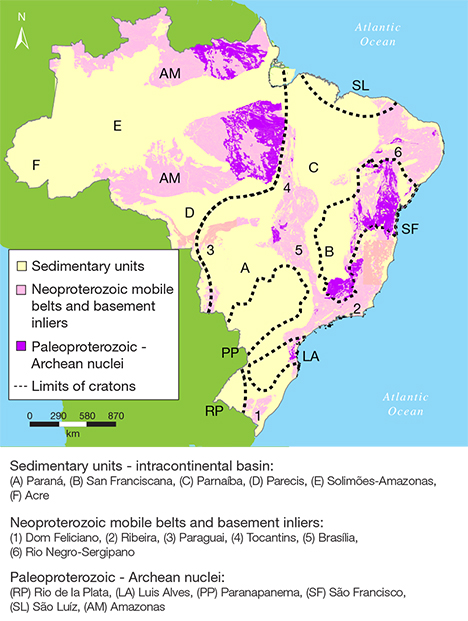
DIAMOND OCCURRENCES
Diamonds occur in several different geologic settings across Brazil. They are usually recovered as loose crystals along rivers in unconsolidated alluvial or glacial sediments, or they are embedded in conglomerates or metamorphosed sedimentary rocks. They are also found in small amounts in a few known kimberlite bodies. Figure 10 shows the locations of the major mining areas (both historical and current) for the different categories of diamond deposits that will be discussed.
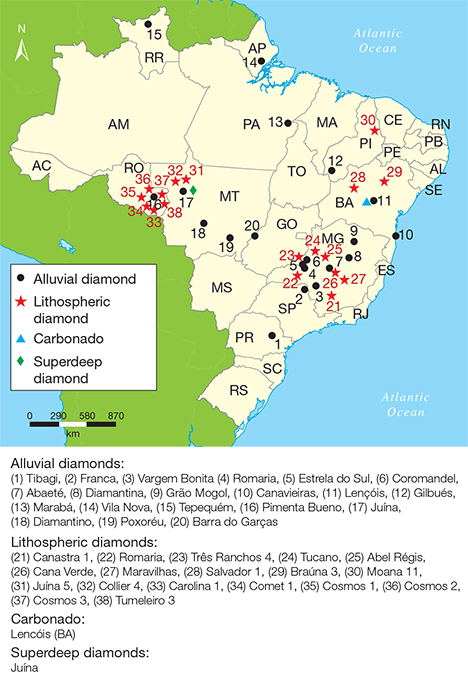
The general geology of Brazil and its important mineral resources have been reviewed by Berbert et al. (1981), Delgado et al. (1994), and Machado and Figueirôa (2001). Further information on the diamond occurrences themselves can be found in Gorceix (1882), Pearson (1909), Cassedanne (1989), and Cornejo and Bartorelli (2010).
Alluvial Diamonds. Alluvial diamonds are recovered as loose crystals directly from rivers or streams, or from geologically recent unconsolidated sediments nearby. These deposits occur throughout Brazil, but the sources in Minas Gerais and Mato Grosso have been the most economically important over the past three centuries.
The recovery of diamonds has involved simple methods used by artisanal miners. Loose diamonds and other heavy minerals are panned directly from a flowing river, or are washed from sediments through a series of sieves. The diamond-carrying sediments are mixtures of clay, sand, silt, gravel, and angular or rounded pebbles; they are often found in horizontal bands or layers, with their contents washed down from higher terrain.
The main detrital diamond deposits are called cascalhos (river gravels). Besides quartz, the gravels may contain heavier pebbles of iron oxide minerals. They are geologically classified as eluvial, colluvial, or alluvial gravels depending on their topographic location and distance from the source.
Figure 11 illustrates several types of diamond deposits in relation to the topography. The diamond-bearing gravels occur as deposits along the bottom or banks of rivers, and along paleo-river channels that are buried beneath younger rocks. Remnants of the buried channels outcrop along riverbanks. The diamonds may also occur in sediments exposed on hillsides. The garimpeiros use various approaches—past discoveries, rumors, intuition, and other means—to identify potential mining areas. They often wait for the dry season to explore the accessible riverbeds, as diamonds can be concentrated in depressions or potholes on the underlying bedrock. In some cases, the course of a river is blocked with a dam, or the water is diverted using a large sluice, providing access to the gravels. Once a potential spot is selected, it may be necessary to remove overlying layers of silt, clay, or sand to reach the diamond-bearing gravels, which tend to lie on or above the solid bedrock. Larger pebbles are removed, and the gravels are then washed using sieves or pans to pick any diamonds by hand (figure 12). The finest-size material is then checked for diamonds as well as small particles of gold (figure 13).
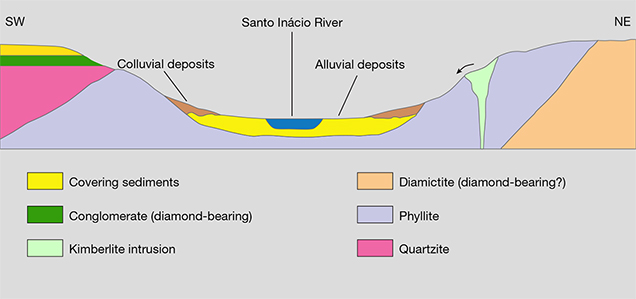

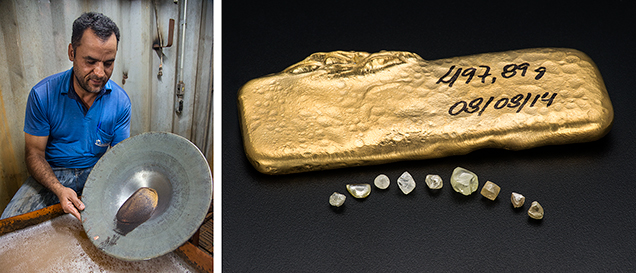
Larger hydraulic systems have sometimes been used to wash diamond-bearing sediments exposed in an outcrop. In the late 1800s and early 1900s, diving suits were used by some miners to retrieve sediments from the river depths. These traditional mining activities have been supplemented by mechanized methods; for example, gravel may be extracted from the river by suction pumps. The pumped water and gravel is then passed through a sluice box that removes the lighter material to recover diamonds and other heavy minerals (Barbosa, 1991). Large, expensive dredges are less common because the low grade of the deposits makes them too costly to exploit with this kind of equipment.
Jequitinhonha River, Minas Gerais. Following the discovery of diamonds in alluvial gravels around Diamantina in the early 1700s, exploration took place along the Jequitinhonha River as well as other rivers and streams in the mountainous Serra do Espinhaço (Derby, 1906; Thompson, 1928). Diamonds occur in metamorphosed sediments of the Mesoproterozoic-age Espinhaço Supergroup. As a result of the weathering of these sediments, diamonds are found in the rivers and streams and in exposed gravels (Karfunkel et al., 1994; Chaves et al., 2001). Mining in this region has been carried out by garimpeiros and later by larger companies, though the peak of activity occurred between about 1740 and 1830.
The alluvial deposits of the Jequitinhonha River have been responsible for most of Brazil’s historic diamond production (Chaves and Uhleim, 1991). In this region, the alluvium consists of a 10- to 45-meter-thick layer of gravel capped by a sand-clay layer. The diamond content of the gravel is approximately 0.6 carats per cubic meter of sediment (ct/m3; Dupont, 1991). In 1966, Mineração Tejucana SA, a diamond mining company based in Diamantina, began using dredges to work the alluvium of this river. The company processed 9 million cubic meters of alluvium per year to recover 70,000 carats of mostly gem-quality diamonds (along with 150 kg of gold) over a period of several years (Dupont, 1991).
Between December 2007 and April 2008, the Peçanha mine near Diamantina, owned and operated by Recursos Mineração Ltda. (a subsidiary of Brazil Minerals Inc.) yielded 4,512 carats of diamonds and 8.95 kg of gold, with average grades of 0.06 ct and 0.14 g per cubic meter, respectively (Watkins, 2009).
Mineraçao Rio Novo is a subsidiary of Andrade Gutierrez SA, a private multinational company headquartered in Belo Horizonte that has been mining along the Jequitinhonha River since 1988. The deposit has a diamond content of about 1.1 ct/m3 and an average production of 25,000 carats per year (Chaves and Uhlein, 1991; Watkins, 2009). Mining involves removing the overlying sediments and using a bucket dredger to excavate the mineralized gravel. Diamonds are recovered from the coarser concentrate in a vibrational circular sieve, while gold is retrieved from the finer concentrate.
Another important project in the Diamantina region is run by Mineraçao Duas Barras, a subsidiary of Brazil Minerals Inc. Data released by the company showed a yield in 2008 of 32,008 carats, with an average value of US$145 per carat (Watkins, 2009). Geological studies of this deposit gave an indicated resource of approximately 1,639,000 m3 of diamondiferous gravel with an average grade of 0.16 ct/m3. A weekly output of nearly 0.5 kg of gold provides a source of revenue to support mining operations.
Poxoréu, Mato Grosso. Poxoréu is located on the northwestern edge of the Paraná Basin. Diamonds were discovered in the Coité River in the 1930s, causing an influx of prospectors. The alluvial deposits are distributed along the Coité, São João, Poxoréu, Alcantilados, Pomba, and Jácomo rivers.
Until the mid-1970s, mining was carried out using only picks, sieves, and panning. St. Felix Ltda. subsequently conducted studies in the Coité River Valley to characterize the diamond reserves—38.6 million cubic meters of gravels were processed, of which about 42% contained diamonds. The average diamond content was 0.05 ct/m3, with an estimated recoverable reserve of 662,000 carats, 27% of it gem-quality (Souza, 1991). According to this reference, there were about 2,500 miners and 150 dredges in the region in the 1980s.
Approximately 70% of the diamond crystals from Poxoréu and Chapada dos Guimarães, both located near the state capital of Cuiabá, display a dodecahedral habit, while the rest display octahedral and mixed habits (Zolinger et al., 2002). All of the diamonds are recovered from sedimentary rocks of the Upper Cretaceous-age Bauru formation (Souza, 1991). Similarly, diamonds mined elsewhere in southeastern Mato Grosso, around the cities of Tesouro, Guiratinga, Alto Garças, Barra do Garças, and Batovi, are related to conglomerates of the same formation (Weska, 1996).
Coromandel, Minas Gerais. The mines around Coromandel began operating in the late 18th century (Des Genettes, 1859). The town was probably named by Portuguese traders for the Coromandel region of India, an important diamond source since antiquity (Legrand, 1980). Also known as the Alto Paranaíba province or the Triângulo Mineiro, this area is the second most important source of diamonds in Minas Gerais, serving as the center of the local diamond trade (figure 14; Leonardos, 1956; Kaminsky et al., 2001; Karfunkel et al., 2014).
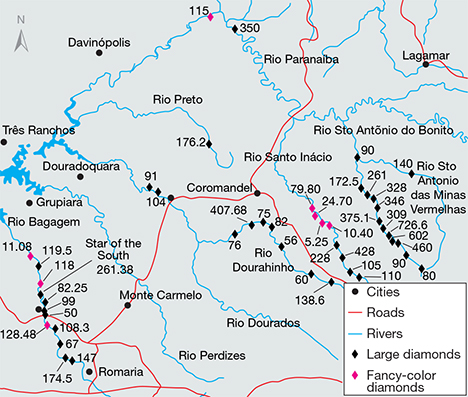
The town itself is located on the eroded rocks of the Brasilia fold belt in western Minas Gerais. The mines occur in alluvial deposits of Cenozoic age, mainly along rivers that cut through the recent sediments as well as metamorphic rocks of the crystalline basement.
The main diamond-mining areas are situated along the Paranaíba, Santo Inácio, Dourahinho, Santo Antônio do Bonito, Santo Antônio das Minas Vermelhas, and Bagagem rivers, and to a lesser extent the Preto and Dourados rivers. In the Paranaíba River, the largest waterway in the region, most mining is done by means of rafts anchored at various points along the riverbed. Heavy mineral concentrates from all of these rivers and streams contain traditional kimberlite indicators: pyrope garnet and magnesian ilmenite in similar proportions, followed by zircon and chromite.
The Coromandel region is famous for its periodic discoveries of large rough diamonds (table 1). The best-known examples are the 726.6 ct Presidente Vargas and the 261.38 ct Star of the South (Hussak, 1894; Reis, 1959; Smith and Bosshart, 2002; Balfour, 2011; also see Abreu, 1973; Svisero, 1995). The Presidente Vargas was found in 1938 along the Santo Antônio do Bonito River. The Star of the South was discovered in 1853 in the Bagagem River, near a village then known by the same name (Dufrenoy, 1855). The area continues to occasionally yield large diamonds, attesting to the great economic potential of these deposits (figure 15).
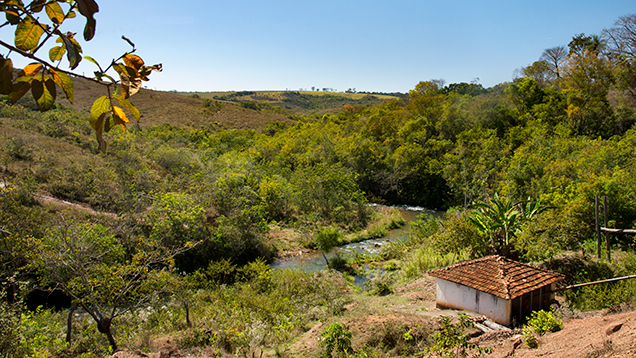
Colored diamonds finds are not rare in Brazil, and they are often not officially registered. Still, there are some notable examples. In 1998, a 7.0 ct pink diamond found in the Vargem mining area near Coromandel was purchased by a diamond dealer for US$650,000. The Giacampos Red, a 5.25 ct crystal found in 2005 in the Santo Inácio River, yielded a 1.57 ct faceted oval. In May 1993, a 602 ct brown diamond discovered in the Santo Antonio do Bonito River (Haralyi et al., 1994) became the second-largest recorded Brazilian gem diamond (surpassed only by the colorless Presidente Vargas). In the fall of 2014, at a site along the Dourahinho River, the mine owners found a flattened 138.6 ct pink crystal, which they were able to sell almost immediately.
In the Coromandel region, large diamonds have also been recovered from the Abaeté, São Bento, Borrachudo, and Indaiá rivers, all occurring in the São Francisco River Basin (figure 16). They are also recovered in the alluvium eroded from Cretaceous conglomerates of the Capacete formation (Read et al., 2004). Examples of large diamonds include the 27.09 ct vivid pink Queen Giacampos and the 13.90 ct Moussaieff Red, both found in the Abaeté River (King and Shigley, 2003). Other discoveries include the 0.59 ct Rob Red, from the São Bento River, and two rough stones of 41.44 and 58.2 carats from the Abaeté River (see references listed in table 1).
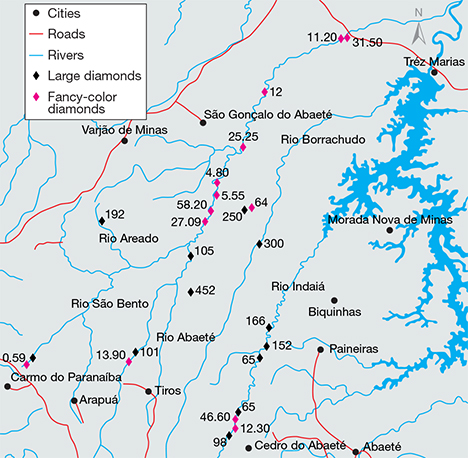
The remarkable Bragança diamond—either 1,680 ct (Mawe, 1812) or 1,730 ct (Ferry, in Reis, 1959), depending on the source—was found in 1797 in the Abaeté region. For many years, the Bragança belonged to the Portuguese crown jewels (Balfour, 2011). Because of its large size and pale appearance, it was once considered a topaz by some historians and traders (Reis, 1959; Balfour, 2011). More recently, Galopim de Carvalho (2006) discussed the possibility that it was a pale aquamarine. Yet this region’s geology is not favorable to the occurrence of either topaz or aquamarine, and it is more likely that the Bragança was indeed a diamond. Its current whereabouts are unknown.
The origin of these large diamonds continues to elude both researchers and mining companies. The geological literature reflects two opposing views. One theory holds that diamonds of all sizes, weathered from kimberlite pipes, were recycled into the alluvium from the conglomerates of the Capacete formation and distributed throughout the Coromandel region (Svisero et al., 1981; Sgarbi and Chaves, 2005). Based on field evidence that seems incompatible with a kimberlite “pipe” origin, the other theory proposes that the diamonds were transported westward into the region from the São Francisco craton by glacial events in the Neoproterozoic and Paleozoic periods (Tompkins and Gonzaga, 1987; Gonzaga and Tompkins, 1991). This alternate view has been difficult for some to accept because there is little understanding of the transport, concentration, and dispersion mechanisms of diamonds in glacial systems in South America (Gonzaga et al., 1994).
Juína, Mato Grosso. The Juína diamond region lies in the southern part of the Amazonian craton and in the northwest of Mato Grosso. Alluvial diamond deposits are located in the basins of the Juína Mirim, Vinte e Um de Abril, and Cinta Larga rivers, all situated southwest of the city of Juína. The alluvium comes from erosion of the crystalline basement rocks and from overlying sediments of the Parecis basin, located on the southeastern edge of the Amazonian craton (Tassinari and Macambira, 1999). The Parecis basin, encompassing an area of 500,000 km2, contains sediments about 6,000 m deep. The Pimenta Bueno and Paranatinga regions in the neighboring state of Rondônia also contain diamond-bearing alluvium.
During the 1980s, the Juína region was the country’s largest producer of industrial diamonds. At its peak, some 30,000 miners produced around 400,000 carats per month (Costa, 2013). Examination of 2,200 crystals by one of the authors (DPS) in 1985 revealed that 90% were of industrial quality, gray to dark brown in appearance. Most were malformed or corroded crystals and crystal fragments.
Late in the decade, large variations were recognized in the abundance of alluvial diamonds in the area. The Cinta Larga River basin and its tributaries—the São Luiz, Porcão, Samanbaia, Mutum, and Central rivers, as well as the Sorriso and Duas Barras streams—all contained large amounts of alluvial diamonds (up to 6–7 ct/m3). In the Juína Mirim River basin, however, there were much lower amounts (0.6–0.8 ct/m3). Besides the high yield of industrial diamonds, the alluvial deposits were also noteworthy for their large diamonds, similar to Coromandel and Abaeté in western Minas Gerais. Haralyi (1991) reported finding eight crystals between 49.5 and 232 ct, along with six industrial diamonds between 52 and 263 ct. According to Costa (2013), in September 1992 a garimpeiro found a 413 ct diamond in the village of Poção. Le Noan (2008) mentioned the discovery of a 452 ct “megadiamond” in alluvial deposits of the São Luiz River. Although sporadic, these finds indicate that the area around Juína also has potential for large diamonds. Watkins (2009) reported that Juína remains the country’s leading producer of industrial diamonds. In the last decade, the estimated output has been on the order of five million carats.
Other Sources. Diamonds were discovered in the state of Roraima in the early 20th century in the Mau River region and later near Vila do Tepequém (located in the Serra do Tepequém). The deposits occur in sediments that originated from conglomerates of the Neoproterozoic Tepequém formation. Present-day alluvial placers occur where the diamondiferous gravel ranges up to 0.80 m thick, and where indicator minerals are present. In some locations, gold is also recovered (Grazziotin and Andrade, 2011).
In the state of Piauí, diamonds mainly occur near the city of Gilbués in alluvial deposits along the Riachão stream, and in colluvium near the towns of Gioninha, Bom Jardim, Compra Fiado, and Boqueirão. At these locations, the diamonds are usually small but of good quality, sometimes reaching values of US$100 per carat or more (Watkins, 2009).
Sublithospheric Diamonds. Juína drew the attention of geoscientists with the discovery of so-called superdeep diamonds in the São Luiz River area in the early 1990s (Wilding et al., 1991; Stachel et al., 2005; Harte, 2010; Kaminsky, 2012). They are believed to have formed at 400 to 800 km, considerably deeper than most diamonds that formed in the continental lithosphere at approximately 140 to 200 km (Thomson et al., 2014). These “sublithospheric” diamonds are characterized by unusual syngenetic mineral inclusions indicating greater formation depth (such as majorite, periclase-wustite, wollastonite, diopside, moissanite, tetragonal garnet, and perovskite). They are mainly low-nitrogen type IIa diamonds. More recently, similar mineral inclusions have been found in samples from the Collier 4 kimberlite in southwest Juína (Bulanova et al., 2010).
Diamonds in Conglomerates. In several locations, sedimentary conglomerates are the host rocks for diamonds. Diamonds are seldom recovered directly from conglomerates, since most mines are developed in unconsolidated sediments. The classic example of a diamond-bearing conglomerate is the Romaria mine (figure 17), located in western Minas Gerais about 500 km from Belo Horizonte.
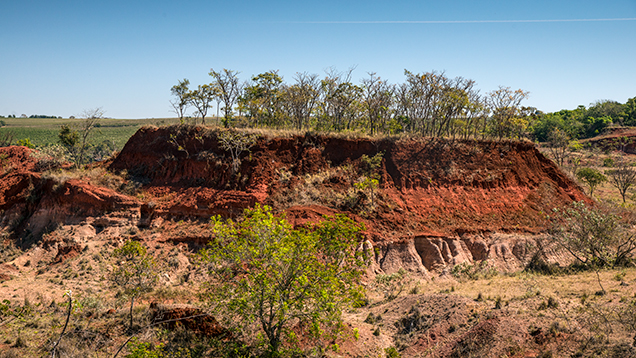
According to Des Genettes (1859), diamonds were first discovered in the Bagagem River in 1722 by the explorer João Leite da Silva Hortis. Large-scale exploration in the Romaria region began in the second half of the 19th century (Hussak, 1894). In the early 20th century, this mine was visited by many foreigners (Porcheron, 1903; Draper, 1911). It was subsequently controlled by various companies, the last of which was Extratífera de Diamantes do Brazil (EXDIBRA), which operated it from 1969 until 1983, when the mine was closed for financial reasons.
The Romaria mine, located near the town of the same name, was excavated using tractors to remove the overlying sediment layer. Trucks transported the ore for washing at a plant that processed up to 600 m3 of ore per day, with the final separation of the diamonds performed manually (Svisero et al., 1981). The mine, located in the northeastern edge of the Paraná basin, covers an area of approximately 1.2 km2. On the property, the Uberaba formation consists of a sequence of conglomerates, sandstones, and mudstones; at the base of this formation are diamond-bearing conglomerates approximately six meters thick (Suguio et al., 1979; Coelho, 2010; see figure 17). The concentrates obtained by washing the conglomerates contain indicator minerals. Chemical analysis revealed that the garnet and ilmenite are of a kimberlitic origin (Svisero, 1979; Svisero and Meyer, 1981; Coelho, 2010). In 1981, during the final phase of the EXDIBRA operation, one of the authors (DPS) examined a parcel of 450 carats of diamonds comprising 5,250 stones of various size, shape, and color. The crystals were predominantly rhombododecahedral in shape; most were colorless, and 70% were of gem quality (Svisero et al., 1981).
During this period, drill core samples were taken to determine the extent of the mineralized conglomerates (Feitosa and Svisero, 1984). The results revealed the presence of small “basins” formed by depressions in both the sandstone and the underlying mica schist. These paleostructures on the crystalline basement were filled by mud flows, giving rise to diamond-rich layers within the conglomerate. Samples also revealed that the diamond-bearing layers measured up to 9.6 m thick, while the average diamond content ranged from 0.33 to 0.69 ct/m3.
Diamonds in Glacial Deposits. Most researchers now accept that diamonds in the Tibagi region of Paraná come from sedimentary glacial deposits (Oppenheim, 1936; Maack, 1968; Liccardo et al., 2012). Tibagi is one of the country’s oldest centers of diamond mining, having been discovered in 1754 by gold prospectors (Leonardos, 1959).
The mines of the Tibagi River basin and the adjacent areas have been worked since the latter half of the 18th century (Derby, 1878). Diamonds occur in the riverbeds in both old and recent alluvium and colluvium. The deposits are distributed in small groups in the southeastern border of the Paraná basin (Perdoncini et al., 2010), and there have been alternating periods of intense mining activity and neglect. The Tibagi deposits were especially active in the first decades of the 1900s, when Oppenheim (1936) noted 60 alluvial occurrences in production.
In the 1980s, Paraná Minerals (MINEROPAR) and the Companhia de Pesquisa de Recursos Minerais (CPRM) conducted fieldwork to assess the deposits in the Tibagi region. They found that the gravels had an average grade of 0.62 ct/m3 (Watkins, 2009). Currently, Jezzini Minerals and Tibagiana Mineração are using ferries to dredge and concentrate the alluvial sediments in the riverbed. The average value of the diamond mined by these companies is US$150 per carat.
This region is characterized by small crystals (0.1–0.3 ct), and historically there have not been discoveries of large diamonds there (Reis, 1959). Sampling of heavy-mineral concentrates from the Tibagi, Laranjinha, Cinzas, Itararé, and Verde river valleys revealed no traditional kimberlite indicator minerals (Chieregati and Svisero, 1990).
In 1985, a diversion of the river channel allowed mining of the sediments in the Tibagi riverbed. This afforded one of the authors (DPS) the opportunity to examine a group of 2,210 diamonds (about 90% of them gem quality). The crystals were generally well formed and euhedral, with a small number of cleavage fragments.
Existing field evidence of glacial striations on local rocks, and the absence of kimberlite indicator minerals, indicates that diamonds in this region were dispersed as the result of glacial transport (Maack, 1968; Chieregati, 1989; Chieregati and Svisero, 1990; Liccardo et al., 2012). The diamonds’ small size, euhedral shape, and overall high quality all suggest that these deposits were subjected to transport processes that favored the retention of the better crystals. In addition, studies have shown that the region contains diamonds with mineral inclusions characteristic of a peridotitic paragenesis, pointing to a kimberlitic initial source (Meyer and Svisero, 1975). Paleogeographic reconstructions (dos Santos et al., 1996) indicate that the original centers where glacial flow took place were located in southern Africa.
Diamonds in Metasedimentary Rocks. Diamonds from metasedimentary deposits occur mainly around the town of Diamantina in Minas Gerais and in the larger region known as Chapada Diamantina in Bahia (figure 18). Both areas are located along the Serra do Espinhaço, a mountain range extending approximately 1,100 km from the center of Minas Gerais north into Bahia (figure 19). Minor deposits are located at Grão Mogol and Serra do Cabral.
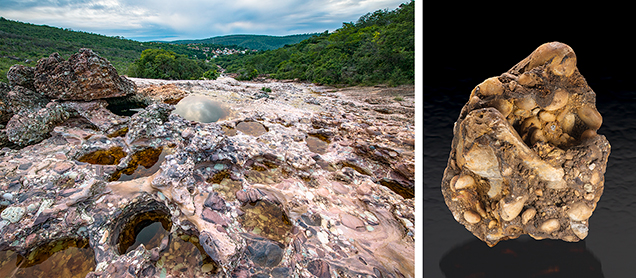
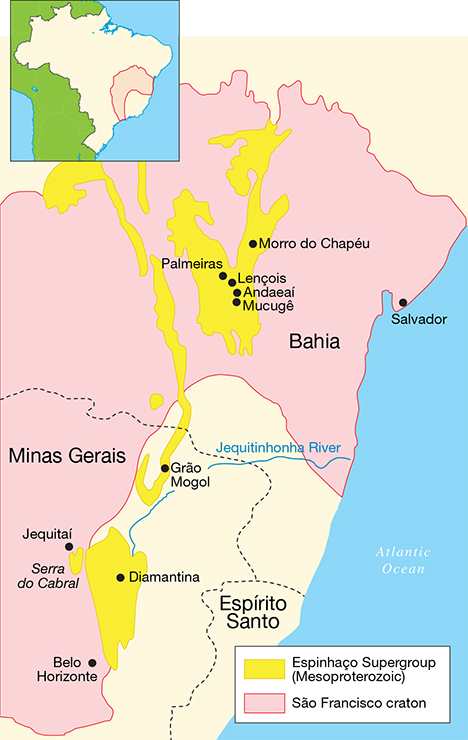
Diamantina. This town is located near the Jequitinhonha River in Minas Gerais. Diamonds occur in metaconglomerates and metabreccias of the Sopa-Brumadinho formation (Mesoproterozoic-age Espinhaço Supergroup; see Chaves and Uhlein, 1991) and in alluvial placers. The primary sources of these diamonds still have not been found.
The diamond-bearing metaconglomerates were deposited in plains and alluvial fans, while the metabreccias were deposited by debris flows, possibly in flat tidal environments (Chaves and Uhlein, 1991). In the Diamantina district, the most important diamond fields are located near São João da Chapada, Sopa, Guinda, Extração, and Datas (Chaves, 1997; Haralyi et al., 1991).
The Sopa metaconglomerates, which are about 12 to 15 m thick, have diamond concentrations ranging from 0.04 to 0.076 ct/m3. Most of the heavy minerals in these sediments are derived from the crystalline basement rocks. Noteworthy is the absence of the traditional kimberlite indicator minerals that are common in the Coromandel region (Chaves, 1997; Svisero et al., 2005). Diamonds from this district are generally small: 90% weigh less than 2 ct, with only 1% above 8 ct. The typical size range is from 0.55 to 0.85 ct (Chaves and Uhlein, 1991).
Large “megadiamond” crystals, such as those recovered near Coromandel and the Abaeté River, have apparently been found in the Diamantina district (Barbosa, 1991). While there are references to stones as large as 140 ct (Renger, 2005), these discoveries occurred during the 18th century, when record keeping was inadequate or nonexistent. In recent decades, crystals above 10 carats have occasionally been found (Chaves, 1997; Renger, 2005).
Most of the diamond crystals from the area are colorless; some exhibit a green or brown surface coloration. The predominant crystal morphology is a dodecahedral habit followed by other shapes, and the majority is of gem quality (Chaves, 1997).
Chapada Diamantina. Bahia was Brazil’s largest diamond producer in the second half of the 19th century. The most important areas are in Chapada Diamantina in the eastern portion of the state, including the towns of Lençóis, Palmeiras, Andaraí, Mucugê, Utinga, and Morro do Chapéu. Around 1821, diamonds were discovered by German explorers Johann Baptist von Spix and Carl Friedrich Phillipp von Martius in the Sincorá Mountains of the Mucugê River region (Abreu, 1973). The explorers had previously visited the deposits of the Diamantina district; based on geological similarities, they searched for and discovered diamonds in Bahia. Mining began in the Mucugê River and then spread throughout the headwaters of the Upper Paraguaçu River. Around 1842, discovery of the Mucugê River placers caused a rush of about 30,000 miners into the region (Leonardos, 1937; Abreu, 1973). The secondary sources of these diamonds are the metaconglomerates of the Tombador formation (Chapada Diamantina Group, part of the Mesoproterozoic-age Espinhaço Supergroup).
In general, these diamonds have dodecahedral habits, or curved forms intermediate between octahedral and dodecahedral. Colorless crystals are the most common, followed by browns and grays. As in Minas Gerais, there are no kimberlite indicator minerals. The primary source of diamonds from the Serra do Espinhaço remains unknown.
Diamond production in Chapada Diamantina peaked between 1850 and 1860, reaching 70,000 carats per year, followed by alternating phases of activity and decline. In 1929, mechanized mining equipment was installed on the Paraguaçu River. After two years of operation, a yield of 2,008 carats of diamond and 4,109 carats of carbonado was recorded. The diamond content at this location was 1 ct per 28 m3 of washed gravel; the carbonado content was 1 ct per 14 m3 (see Abreu, 1973).
Carbonado. Around 1841, miners in Chapada Diamantina discovered that some dark grains in the heavy mineral concentrates had the same hardness as conventional diamonds. They had discovered a new type of “diamond” with completely different physical properties, which they called carbonado (Rivot, 1848; Leonardos, 1937; Herold, 2013; see figure 20). Derby and Branner (1905) and Branner (1909) described the washings in Bahia where carbonado and diamond are found.
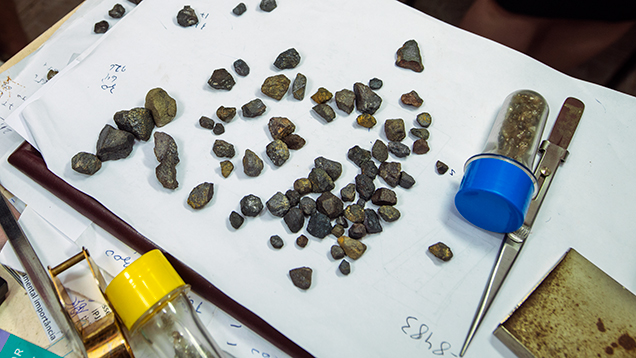
Carbonado is a polycrystalline aggregate—opaque, solid but porous—consisting of a mixture of diamond, graphite, and amorphous carbon (Haggerty, 2014). Compared with monocrystalline diamonds, which have perfect cleavage and a density of 3.51 g/cm3, carbonados are free of cleavage and have slightly lower densities (ranging from 3.0 to 3.4 g/cm3). They can display a glass film, or patina, that is never observed on diamond crystals (Haggerty, 2014). Besides having the same hardness of conventional diamond, carbonado has great toughness, and its resistance to impact made it an excellent material for industrial use by the late 1800s (Herold, 2013).
Carbonados are generally about 1 cm in size but occasionally weigh tens or even hundreds of carats. Decades ago, several “megacarbonados” emerged from the mines of Chapada Diamantina. The greatest was the Sérgio—at 3,167 carats, the largest diamond ever found in nature—discovered at Brejo da Lama near Lençóis in 1905. Another example is the 2,000 ct Casco de Burro, found in Lençóis a year later (Leonardos, 1937).
Although Chapada Diamantina is the traditional source of carbonado, this material is also mined in Minas Gerais, Mato Grosso, Goiás, Paraná, and Roraima (Reis, 1959; Chaves, 1997). Some famous carbonados are the Pontesinha (267.53 ct) from West Rosário, Mato Grosso (Reis, 1959), and an 827.5 ct specimen found in the Abaeté River in 1934 (Leonardos, 1937). In each of these localities, carbonados occur in alluvial deposits associated with normal crystalline diamond (Chaves, 1997).
The production and trade of carbonados in Chapada Diamantina peaked in the second half of the 19th century. At the time France maintained a consulate in Lençóis to facilitate the purchase and export of this material to Europe (Abreu, 1973; Herold, 2013). Production went into decline after 1929, when the price fell by nearly 97% due to increased availability of industrial diamonds from African countries (Reis, 1959). Prospecting dwindled before officially ending on September 17, 1985, with the establishment of Chapada Diamantina National Park (Andrade, 1999).
The origin of carbonados remains controversial. Typical monocrystalline diamond is related to three distinct geological phenomena: (1) transport from the earth’s deep interior by explosive volcanism (volcanic diamonds), (2) continental collision followed by subduction and exhumation (metamorphic diamonds), and (3) meteoritic impact (impact diamonds). Recent evidence indicates that carbonado does not fall into any of these categories. Haggerty (2014) suggested an extraterrestrial origin, in which the carbonados formed in a white dwarf star, a carbon-rich exoplanet, or a supernovae explosion during a cosmic bombardment between 4.1 and 3.8 billion years ago.
Kimberlite. The systematic exploration of Brazil’s primary kimberlite sources only began in the late 1960s. Figure 21 presents a country map showing the locations of known kimberlite pipes. Karfunkel et al. (1994) cited several reasons for this lack of detailed exploration, including the wide areas over which alluvial diamonds are found, the historical control over these areas by garimpeiros who often prevented exploration, the intense tropical weathering and erosion that removed the upper sections of kimberlite pipes, and (until recently) the absence of published information from mining companies searching for kimberlite bodies.
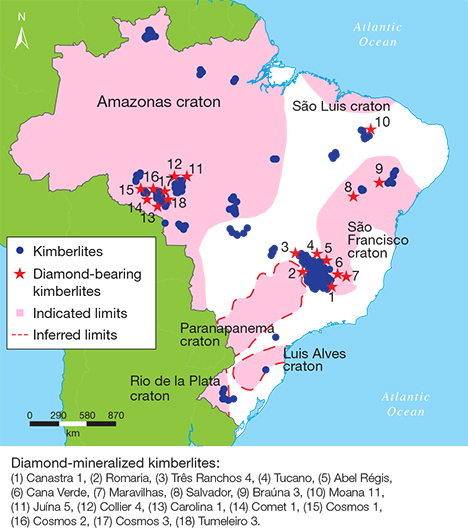
The Redondão kimberlite was the first such body found, during geological mapping in the southern Parnaíba Basin in the 1960s. This pipe is located southeast of the city of Santa Filomena in Piauí state. It has a circular shape, with a diameter of 1,000 m and a negative relief of about 70 m in relation to the surrounding rocks.
Several mining companies have undertaken prospecting for kimberlites in Brazil, especially Pesquisa e Exploração de Minérios S/A (SOPEMI), a De Beers subsidiary that has operated for more than three decades. After finishing its exploration activities, this company transferred its database on 1,212 kimberlites to the state-owned CPRM. About 700 of these kimberlites occur in the Alto Paranaíba region in western Minas Gerais and southeastern Goiás.
The kimberlites of the Alto Paranaíba province, located southwest of the São Francisco craton, were mostly intruded into rocks of the Brasília fold belt. The Vargem 1 kimberlite, in the floodplain of the Vargem Fazenda near Coromandel, was the first body found in the region (Meyer et al., 1991). It is 700 m in diameter and consists of serpentinized kimberlitic rocks that intrude the Vazante phyllite formation (figure 22). The pipe contains abundant pyrope garnet, magnesian ilmenite, diopside, and chromite, as well as some zircon. The diamond potential of this body is still being investigated.
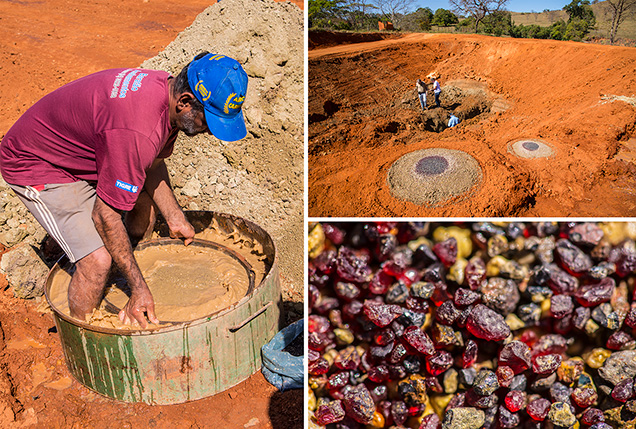
Other kimberlite bodies in the Coromandel region are Três Ranchos 4 (Fazenda Alagoinha), Limeira, and Indaiá. These consist of hypabyssal kimberlite rock facies with isotopic characteristics intermediate between Group 1 and Group 2 kimberlites (Bizzi et al., 1993; Melluso et al., 2008; Guarino et al., 2013).
Três Ranchos 4 was the first kimberlite in the area known to contain diamonds (Gonzaga and Tompkins, 1991), though not in sufficient quantity for commercial exploitation. Another well-known kimberlite is Abel Regis, a mineralized intrusion in the Serra da Mata da Corda (Cookenboo, 2005). This pipe is located 20 km northwest of Coromandel (again, see figure 14), and it is intruded into the Neoproterozoic-age Bambuí Group (CPRM, 2013). It has an elliptical shape and an area of approximately 1 km2. Serpentinization of the kimberlite yielded a green saprolite clay containing fragments of pyrope, magnesian ilmenite, and diopside. Most of the garnets from this kimberlite, and from several others of the Upper Paranaíba region, are lherzolitic in nature (G9). They are followed by eclogitic garnets (G4 and G5); G10 garnets are either rare or absent (Cookenboo, 2005; Svisero et al., 2005). These G-numbers represent a statistical classification of garnets from kimberlites and associated xenoliths, developed by Dawson and Stephens (1975), that is used in diamond exploration. According to local miners, diamonds up to 20 carats have been found in ravines in the area of the intrusion.
Other mineralized kimberlite pipes include Tucano, located west of Carmo do Paranaíba (Cookenboo, 2005), and the Romaria kimberlite located northeast of the Romaria mine (F.M. Coelho, pers. comm., 2008). Another important diamond-bearing kimberlite is the Canastra 1, located in the headwaters of the São Francisco River near São José do Barreiro in the Serra da Canastra region (Cookenboo, 2005). It intrudes quartzites of the Canastra Group (Barbosa et al., 1970) that are part of the Brasília fold belt of Mesoproterozoic age (Chaves et al., 2008). Canastra 1, dated at 120 million years, comprises two subcircular bodies oriented along the regional northwest-southeast trend of the Canastra Group metasediments. Trial mining conducted in 2007 indicated the presence of 16 carats of diamond per 100 tons of rock (Chaves et al., 2008). Eighty percent of the recovered diamonds were gem quality; the crystals were octahedral in shape and colorless to faint yellow. These characteristics make the diamonds from this area some of Brazil’s most valued. Other mineralized bodies include the Maravilhas kimberlite located near the city of the same name, and the Cana Verde pipe located north of the city of Luz, both in the southern portion of the São Francisco craton (O. Barbosa, pers. comm., 1978).
Several diamond-bearing kimberlites occur in Juína, where they intrude into the Rio Negro–Juruena mobile belt (1.55 to 1.8 Ga). Among others, the Collier 4 kimberlite has an average grade of 0.62 ct/m3. Mining companies have recovered 6,000 diamonds from this pipe, including a 17.08 ct stone (Costa, 2013). The pipe contains sublithospheric diamonds, which have mineral inclusions and other features that suggest they formed at great depth (Bulanova et al., 2010). Another pipe, Juína 5, also contains sublithospheric diamonds—mainly contact-twinned and octahedral crystals—that appear corroded and are covered with a graphite film (Thomson et al., 2014).
Rondônia has 62 kimberlites distributed in the Pimenta Bueno, Colorado do Oeste, and Ariquemes fields. According to Neto et al. (2014), it ranks fourth in terms of known occurrences after Minas Gerais (765), Goiás (197), and Mato Grosso (102). Among the mineralized kimberlites in Rondônia, perhaps the most important is the Carolina 1 pipe, located near Pimenta Bueno. It intrudes into rocks of the Rio Negro–Juruena mobile belt (Tassinari and Macambira, 1999); the age of the intrusion is 230 Ma (Hunt et al., 2009). Although diamond-bearing, this kimberlite is characterized by the absence of G10 garnets in the heavy mineral concentrates obtained by washing the ore. Such garnets are rare in other kimberlites in Minas Gerais, Bahia, and Mato Grosso (Cookenboo, 2005; Svisero et al., 2005). Analysis of a small batch of diamonds indicated that the predominant color is gray (48%), followed by colorless (23%) and others (Hunt et al., 2009). Other mineralized pipes include Cosmos 1, 2, and 3; Comet 1; and Tumeleiro 3 (Neto et al., 2014).
There are two areas with kimberlite concentrations in Piauí. The first is located in the southern region where, besides the famous Redondão kimberlite, several intrusions are distributed in the municipalities of Santa Filomena, Gilbués, Currais, and Baixa Grande do Ribeiro. The second is in the eastern region, covering the municipalities of Picos, Ipiranga do Piauí, Elesbão Veloso, Jardim do Mulato, and Regeneração. The Moana 11 kimberlite near Picos contains diamonds, but it has been little studied to date.
Diamond-bearing kimberlites also occur in Bahia State (Watkins, 2009) in the northeastern São Francisco craton. The Salvador 1 kimberlite, located near Barra do Mendes, intrudes metaconglomerates of the Tombador formation. Rb/Sr dating of the intrusion indicates an age of 1,152 Ma, making it the oldest known intrusion in the country. Also, the pipe’s intrusion into rocks in the Serra do Espinhaço provides evidence of a period of diamond-bearing kimberlite magmatism generated in the region.
The most important kimberlite pipe at present is Braúna 3 (see box B), which contains diamonds in commercial concentrations. This pipe is located about 260 km from Salvador, in the northeast portion of the São Francisco craton. It occurs as part of a kimberlite field consisting of three pipes and 19 dikes, all diamond bearing and intruding the Nordestina granodiorite (a batholith of Paleoproterozoic age; see Donatti-Filho et al., 2013). The dikes range from 0.5 to 5.0 m thick, and they are controlled by northwest-trending fractures that can be followed for 15 km. All volcanic pipes and dikes of the Braúna field belong to the hypabyssal facies. The age of the kimberlites, obtained by U/Pb dating of perovskites, is 642 +/- 6 Ma. The Braúna kimberlites have mineralogical and geochemical similarities to those in the Guaniamo region of Venezuela (Donatti-Filho et al., 2013). The Braúna 3 pipe is now being commercially exploited by Lipari Mineração Ltda.
PRODUCTION
Since the discovery of diamonds in South Africa, Brazil has never regained its standing, and in recent decades it has accounted for less than 1% of global production. According to Minérios & Minerales (2014), the estimated production between 1725 and 1870 was 50,000 to 250,000 carats per year; if the larger value is assumed, this would yield a total of 37.5 million carats over the 150-year period. As most Brazilian occurrences are alluvial, it has always been difficult to determine the amount and commercial value of what is recovered.
Production increased with the discovery of diamonds in other Brazilian states in the 19th and 20th centuries, but under limited government oversight. Production in the early 1970s was approximately 300,000 carats per year, before jumping to 670,000 carats in 1980. This significant increase was due to the Juína mines, and Mato Grosso became the country’s principal source of diamonds. In recent years, production has declined significantly, to less than 32,000 carats in 2015 (http://kimberleyprocessstatistics.org). This number is expected to increase significantly with the mining of the Braúna 3 kimberlite in Bahia. Open-pit mining is expected until 2021, with the potential for mining to continue underground.
Brazil has participated in the Kimberley Process Certification Scheme (KPCS) since 2003. Underreporting of annual production, along with corruption and criminal activity in diamond exporting and sales, has been endemic (see Partnership Africa Canada, 2005, 2006). Experts believe the stringent certification requirements of the KPCS have caused exports to be underreported, particularly for valuable material such as fancy-color diamonds (Gomes dos Santos, 2015).
Considering the widespread distribution and mode of occurrence of Brazilian diamonds, and the lack of historical controls over mining, underreporting is not surprising. In countries where diamonds are recovered from kimberlite pipes, control is more easily maintained over the small area. But Brazil is one of the world’s largest countries, and the secondary deposits cover vast areas. Alluvial mining and initial diamond sales are carried out by garimpeiros, individually or in small groups, with no large companies exerting control. With Brazil’s long coastline and remote borders with neighboring countries, diamond smuggling is an ever-present concern.
CONCLUSIONS
Brazil’s significance as a diamond producer spans three centuries, making it the world’s longest continuous commercial source of diamonds (figure 23). Brazil reached its peak production in the mid-1700s as adventurers and explorers made their way into the country’s vast interior. Most of its diamond supply—then and now—comes from the multitude of alluvial sources spread across the country.
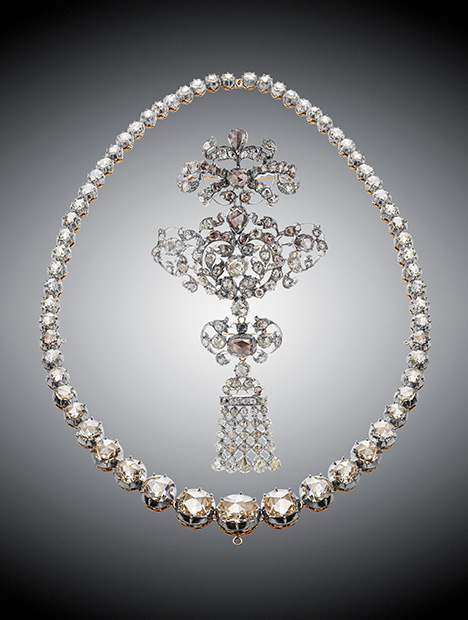
Alluvial diamonds have been mined in most Brazilian states since the beginning of the 18th century, when the colony was still under Portuguese rule. Besides alluvial occurrences, there are other important deposits related to conglomerates (Romaria, Minas Gerais), glacial rocks (Tibagi, Paraná), and mid-Paleozoic metasedimentary rocks (Diamantina District, Minas Gerais and Chapada Diamantina, Bahia). Among the alluvial deposits, the Coromandel and Abaeté regions have occasionally yielded “megadiamonds” reaching hundreds of carats in size, as well as crystals with pink, yellow, green, red, and blue “fancy colors.” The mines of the Juína region in Mato Grosso are known for the quantity of their production.
Although systematic exploration of Brazilian kimberlites began relatively late, there are several known mineralized bodies in the states of Minas Gerais, Bahia, Mato Grosso, Rondônia, Goiás, and Piauí. Large mining groups such as De Beers have worked in Brazil but never at a reported kimberlite source. However, more than 1,300 kimberlite pipes have been identified through exploration in the last century.
The past three centuries have shown the importance of mining to Brazil’s economic development. Since the beginning, garimpeiros have worked the remote regions, founding towns that later became cities such as Diamantina, Coromandel, and Juína. In the ongoing search for new mineral deposits, the garimpeiros pushed west beyond the boundaries of the Treaty of Tordesilhas, helping expand Brazilian territory. Beginning in the 1700 and 1800s, Brazilian diamonds were used in European jewelry—the larger and better-quality diamonds found their way into royal jewelry collections at a time when production from India had ceased and the African deposits had yet to be discovered.
Another important development was the discovery of carbonado in Chapada Diamantina in the 1840s. In the early 1990s, sublithospheric diamonds were discovered in the kimberlites of Juína in Mato Grosso. These unusual diamonds contain inclusions of minerals formed in the transition zone and lower mantle. Their study has increased our awareness of the mineralogy of Earth’s interior.
Brazil’s diamond production remains enigmatic. The country’s enormous expanse, and the fact that diamonds have been found at numerous alluvial sources, weathered over the millennia from their primary sources and dispersed throughout the continent in riverbeds and conglomerates, contributes to the confusion. A lack of expertise in large-scale diamond mining, and industry regulation, have also hampered growth in the sector (A. Epstein, pers. comm., 2015). According to Constance (2011), recent production has stalled for several reasons: government efforts to comply with the Kimberley Process Certification Scheme, its crackdown in 2006 on diamond smuggling, and the 2008 global financial crisis. When combined with the shortage of skilled labor and the limited availability of geological resources that can be applied to mineral exploration, an expanded diamond mining program seems unlikely in the near future.
However, Brazil’s diamond production may yet be rewritten in the early 21st century. Despite considerable geological fieldwork, the sources of most alluvial diamonds in Brazil are still uncertain. As large-scale mining will be conducted in at least one location, the traditional scene of garimpeiros panning for alluvial diamonds likely represents a vanishing way of life.
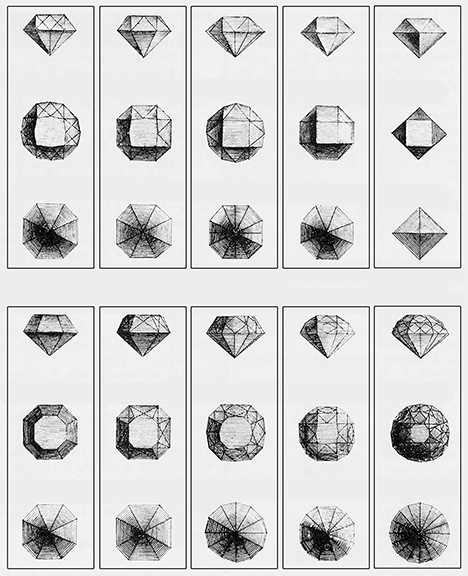
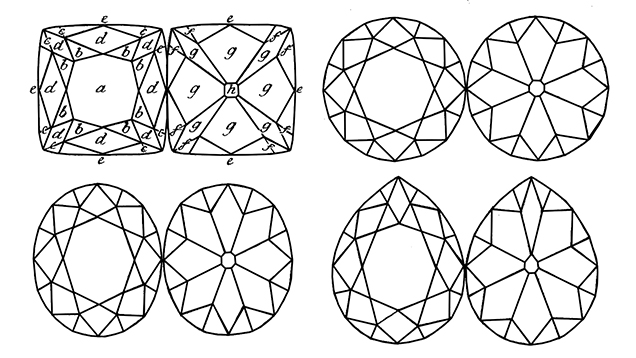


.jpg)


